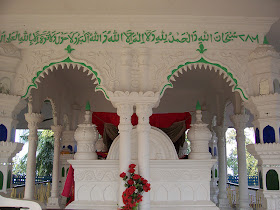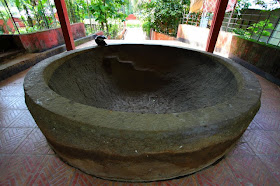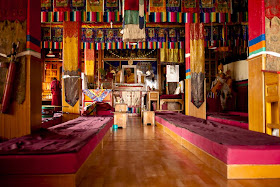It always a pleasure to go to mom’s house and for me its double pleasure. First, I will be meeting my parents and secondly, I will get the chance to see more exotic places in Andaman & Nicobar Islands. This time, I decided to explore Baratang Island. I have heard a lot of stories about Parrot Island which is a part of Baratang Island. The Parrot Island is a natural habitat for parrots in this region. Thousands of parrots returning home before every sunset is a unique and must see view for all nature lovers. I thought of visiting this unique Parrot Island.
We started off early morning for Baratang Island. Baratang Island is located at about 100 Km off the Capital city of Port Blair on the NH 223 (known as Andaman Trunk Road) towards Diglipur. We went through our car and than from a ship.
This island has dense Tropical Forests of all types ranging from tidal swamp forest to Evergreen to littoral forests laced with sandy beaches along its coast at Baludera, Roglachang etc. But my eyes were searching for parrot Island.
The guide told us that we will go to parrot island through a small boat at around 3:30 pm, so that we can see the thousands of parakeets (mixed group) roost in this island every night. We spent our time visiting lime cave and mud volcano in Baratang Island.
At 3:30 pm, we reached at Jetty and took a quick boat ride to Parrot Island. The ride was for 30 minutes but it was an awesome experience to sit in a tiny boat and ride in such a harsh sea. While we were enjoying the ride, our guide showed us a tiny Island and said “that’s Parrot Island!!!”.
As we approached nearer, we saw a uniquely different group of Mangrove trees that looks more like an evenly cut Mangrove garden. On this lovely, dense island, each evening thousands of parrots flock together and roost here. They leave this island next morning. What is striking is that the mangroves on this island are trimmed from time to time by the parrots themselves using their beaks in a near-perfect manner.
Our boat was stopped at around 500 mts from Parrot Island. Parrot Island turned out to be a very small piece of mangrove right in the middle of nowhere! My mind was working overtime. I could see that this particular patch of mangrove had been neatly pruned by the birds and looked close to a just plucked, tea garden! Why just this patch? Only questions no answers!
Why, how, where, what? All these questions were coming to my mind but my guide can just answer one question - WHEN.
They know that as the sun sets, a group of about five parrots flies over Parrot Island and leaves. Then comes a similar group which the locals say comes for an initial inspection. And then within ten minutes we see birds coming over from all the directions and settle down in the forest. It was a mesmerizing experience. The landing of parrots can be viewed from boats and it's an incredible experience to watch such a huge number of parrots landing here.
The quite sea is still silent but the silent island is now a roosting ground for many parakeets. The birds that come to Parrot Island are called parakeets as they are varied groups.
Sitting in boat for about 45 mins and watching the birds come and roost and fly inside outside the island was an amazing feeling. I cannot leave from there without wondering 'why only Parrot Island?'
How to Reach: Reach Baratang from Port Blair by STS bus or a taxi or by boat. From Baratand Jetty, take a Dunghi boat ride. There are regular ferries from Baratang Jetty to Parrot Island. It is better to visit in the evenings if you want to see parrots.
Where to Stay: Forest and Government guest houses are there near to Jetty.
 |
| Thousands of parrots returning to Parrot Island before every sunset |
We started off early morning for Baratang Island. Baratang Island is located at about 100 Km off the Capital city of Port Blair on the NH 223 (known as Andaman Trunk Road) towards Diglipur. We went through our car and than from a ship.
 |
| Baratang Jetty |
The guide told us that we will go to parrot island through a small boat at around 3:30 pm, so that we can see the thousands of parakeets (mixed group) roost in this island every night. We spent our time visiting lime cave and mud volcano in Baratang Island.
 |
| Mangroves Trees |
 |
| AwesomeView while going towards Parrot Island |
 |
| Our Boat moving quickly towards Parrot Island |
At 3:30 pm, we reached at Jetty and took a quick boat ride to Parrot Island. The ride was for 30 minutes but it was an awesome experience to sit in a tiny boat and ride in such a harsh sea. While we were enjoying the ride, our guide showed us a tiny Island and said “that’s Parrot Island!!!”.
 |
| Parrot Island View from distance |
As we approached nearer, we saw a uniquely different group of Mangrove trees that looks more like an evenly cut Mangrove garden. On this lovely, dense island, each evening thousands of parrots flock together and roost here. They leave this island next morning. What is striking is that the mangroves on this island are trimmed from time to time by the parrots themselves using their beaks in a near-perfect manner.
 |
| Parrot Island |
Why, how, where, what? All these questions were coming to my mind but my guide can just answer one question - WHEN.
 |
| We stopped at 500 mt from Parrot Island |
 |
| Sunset at Parrot Island |
 |
| Differnt shades of sea and sky while waiting for Parrots |
 |
| Finally sun was setting down near Parrot Island |
 |
| Parrots are landing in groups to this unique Island |
How to Reach: Reach Baratang from Port Blair by STS bus or a taxi or by boat. From Baratand Jetty, take a Dunghi boat ride. There are regular ferries from Baratang Jetty to Parrot Island. It is better to visit in the evenings if you want to see parrots.
Where to Stay: Forest and Government guest houses are there near to Jetty.








































